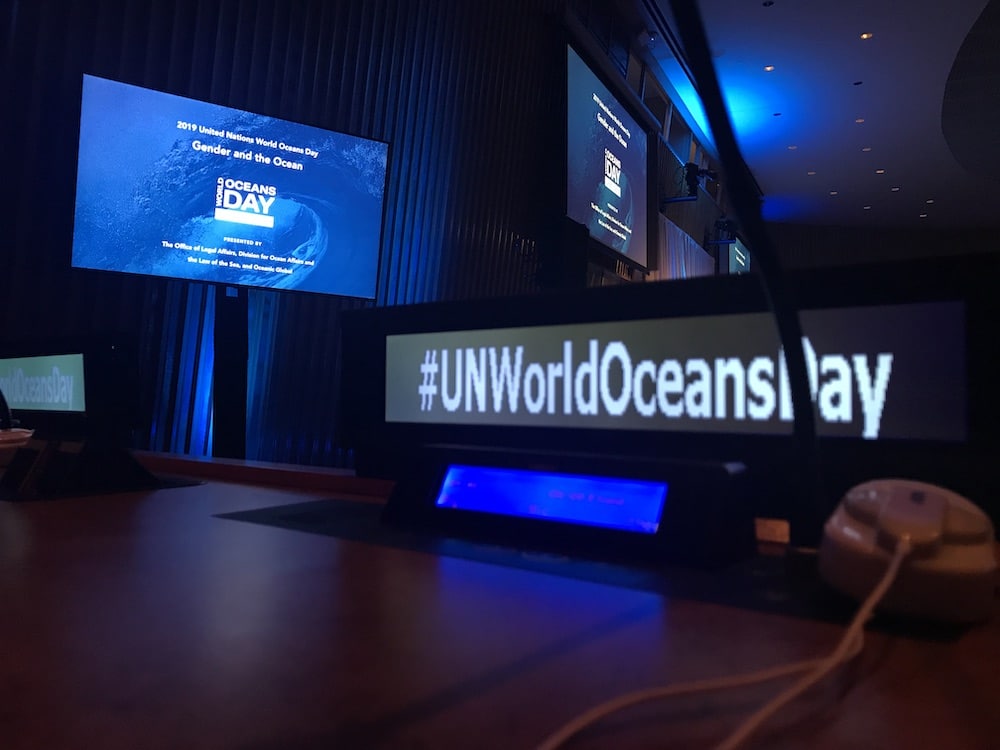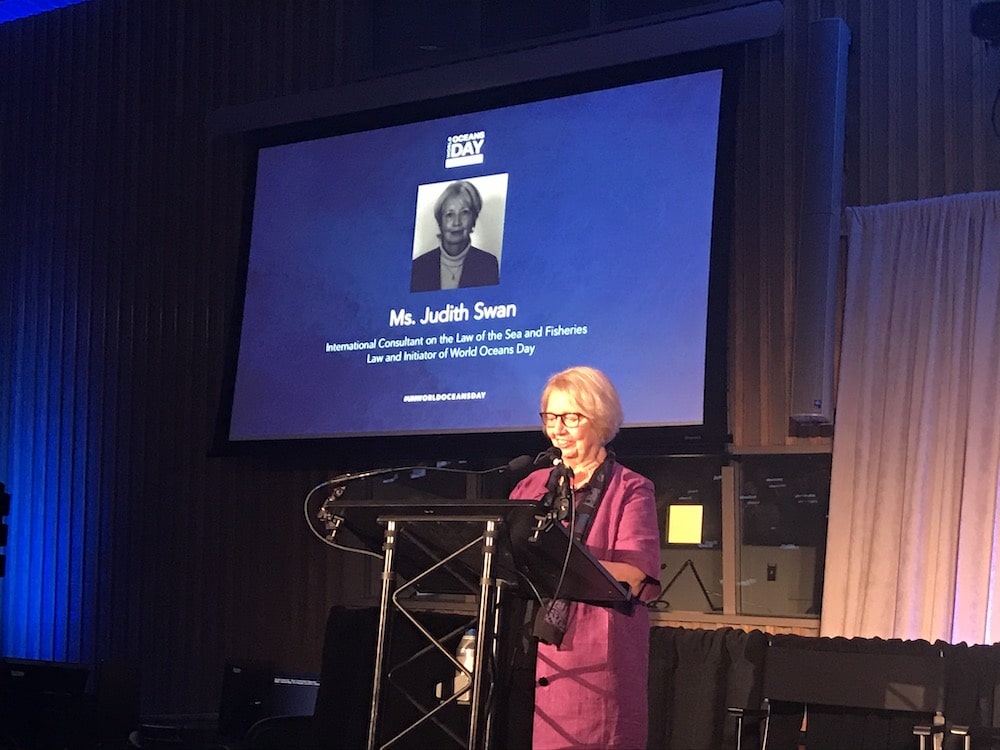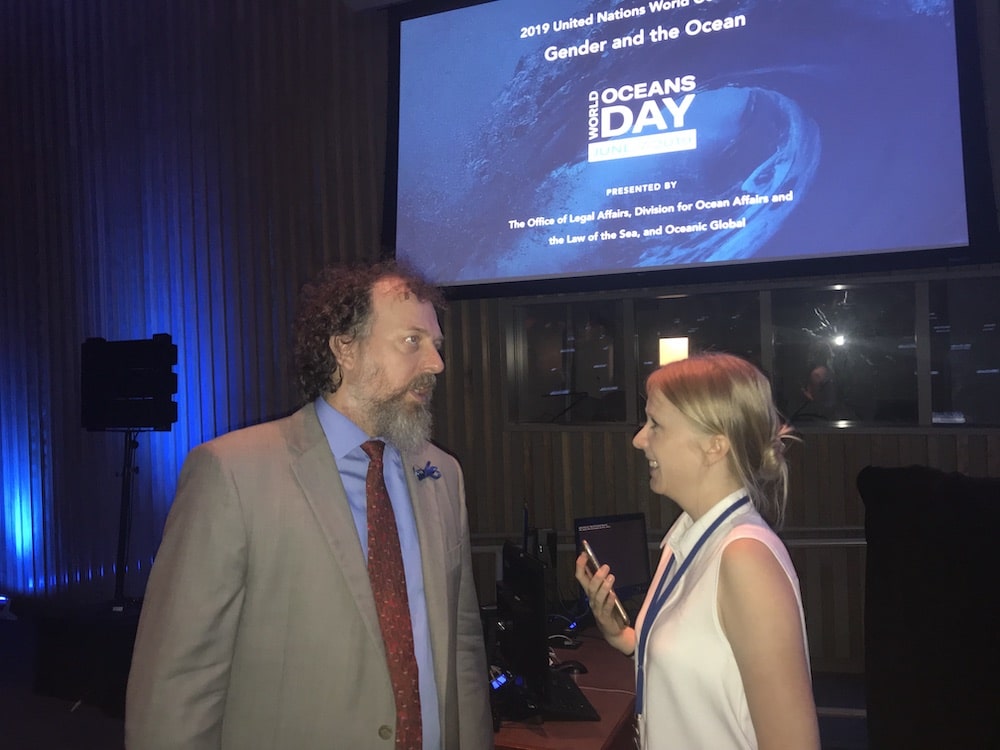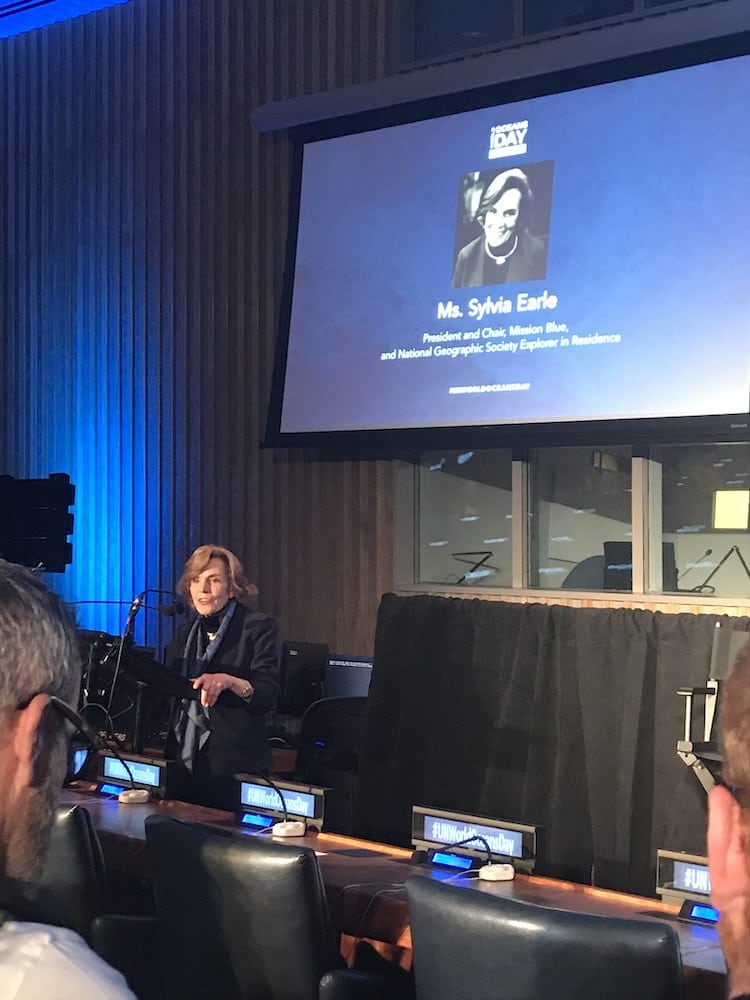Marine Life & Conservation Blogs
Why every day should be World Oceans Day…

Every day should be World Oceans Day, but until my wish is granted we’re grateful for the one day a year the oceans get global attention.

Welcome to UN WOD 2019!
In 2008 the United Nations officially recognized World Oceans Day to be celebrated on the 8th June every year. Since that was a Saturday in 2019, the celebratory event at the United Nations Headquarters in New York took place on Friday 7th themed: Gender and Oceans.

Judith Swan, International Consultant on the Law of the Sea and Fisheries Law, and Initiator, World Oceans Day.
This year the strategic partner Oceanic Global organized a morning of storytelling by men and women and an afternoon panel discussion regarding solutions for gender issues with panellists from the Human Rights at Sea, UN Division of Ocean Affairs and Law of the Sea, the World Surf League and many others.

Kudzi Victorino Dykman at the start of UN WOD 2019 at the NY Headquarters.
Some highlights of the day were the testimony of Kudzi Victorino Dyckman. She was born in Mozambique as the oldest of 14 children and worked as a young child to help provide for her family. Her strong willpower and gratefulness eventually led to her becoming the first female Dive Instructor in Mozambique!

François Bailet from the Office of Legal Affairs – Division of Ocean Affairs and the Law of the Sea – is the driving force behind the UN WOD. Here, in discussion with Amanda Elise Stoltz.
And what about the real life Moana: Aunofo Havea – a true seafarer following the stars and her dream, from cleaning to cooking to captain because she wanted to be the decision maker, while raising a family! Some people in the dive industry might know her as an inspirational power woman operating in Tonga – her dream since she first swam with the whales.

Storytelling panel: Ms. Angelique Pouponneau, Kudzi Victorino Dykman, Aunofo Havea, Anne de Carbuccio, Patima Tungpuchayaku, and moderator Mariasole Bianco.
We also heard goosebump testimonies from a former slave at sea and now the founder of Labour Rights Promotion Network Foundation, Mr. Tun Lin.
In between the stories and panels, I had the honour to announce the winners of the 6th UN World Oceans Day Photo Competition. The overall winner, David Salvatori from Italy, presented a stunning shot of a diver between floating tunicates! A symbol that we need the motion in the ocean to keep them rich and full with life. Check back here tomorrow to see the images!

Expert panel with moderator Natasha Berg, Anamika Amani, Francesca Santoro, Lynn Zebeda, Kendall Barbery, Amanda Hastings, Gabriele Goettsche-Wanli and Paige Alms.
The day ended with a compelling speech by Dr. Sylvia Earle about the knowledge we have and the choices we make, or rather not make fast enough. We have to make peace with nature and that is not a gender issue but a cultural one. But women with superpowers all around the world can make a difference as we should provide the values at home so they become second nature.
We can do this partly by embracing the differences there are between men and women and using the differences in decision making like ones we all make at home: what shall we eat? We have to stop eating marine life because we’re all guilty in playing a part in the atrocities happening at sea if we don’t. In our food choices, we are implicated in everything from overfishing to forced labour at sea.

Dr. Sylvia Earle delivering the closing keynote speech and moving everyone to tears.
When a scientist with the experience and hours in the ocean like Dr. Earle tells you what to do… you better listen!
Conclusion: Gender and the Oceans seemed like a difficult theme when it got announced months ago, but the day was too short once the dialogue began! To be continued…
Find out more about Ellen and her work at www.ellencuylaerts.com.
Marine Life & Conservation Blogs
Creature Feature: Dusky Shark

 In this series, the Shark Trust will be sharing amazing facts about different species of sharks and what you can do to help protect them.
In this series, the Shark Trust will be sharing amazing facts about different species of sharks and what you can do to help protect them.
This month we’re taking a look at the Dusky Shark, a highly migratory species with a particularly slow growth rate and late age at maturity.
Dusky sharks are one of the largest species within the Carcharhinus genus, generally measuring 3 metres total length but able to reach up to 4.2 metres. They are grey to grey-brown on their dorsal side and their fins usually have dusky margins, with the darkest tips on the caudal fin.
Dusky Sharks can often be confused with other species of the Carcharhinus genus, particularly the Galapagos Shark (Carcharhinus galapagensis). They have very similar external morphology, so it can be easier to ID to species level by taking location into account as the two species occupy very different ecological niches – Galapagos Sharks prefer offshore seamounts and islets, whilst duskies prefer continental margins.
Hybridisation:
A 2019 study found that Dusky Sharks are hybridising with Galapagos Sharks on the Eastern Tropical Pacific (Pazmiño et al., 2019). Hybridisation is when an animal breeds with an individual of another species to produce offspring (a hybrid). Hybrids are often infertile, but this study found that the hybrids were able to produce second generation hybrids!
Long distance swimmers:
Dusky sharks are highly mobile species, undertaking long migrations to stay in warm waters throughout the winter. In the Northern Hemisphere, they head towards the poles in the summer and return southwards towards the equator in winter. The longest distance recorded was 2000 nautical miles!
Very slow to mature and reproduce:
The Dusky Shark are both targeted and caught as bycatch globally. We already know that elasmobranchs are inherently slow reproducers which means that they are heavily impacted by overfishing; it takes them so long to recover that they cannot keep up with the rate at which they are being fished. Dusky Sharks are particularly slow to reproduce – females are only ready to start breeding at roughly 20 years old, their gestation periods can last up to 22 months, and they only give birth every two to three years. This makes duskies one of the most vulnerable of all shark species.
The Dusky Shark is now listed on Appendix II of the Convention on the Conservation of Migratory Species (CMS), but further action is required to protect this important species.
Scientific Name: Carcharhinus obscurus
Family: Carcharhinidae
Maximum Size: 420cm (Total Length)
Diet: Bony fishes, cephalopods, can also eat crustaceans, and small sharks, skates and rays
Distribution: Patchy distribution in tropical and warm temperate seas; Atlantic, Indo-Pacific and Mediterranean.
Habitat: Ranges from inshore waters out to the edge of the continental shelf.
Conservation status: Endangered.
For more great shark information and conservation visit the Shark Trust Website
Images: Andy Murch
Diana A. Pazmiño, Lynne van Herderden, Colin A. Simpfendorfer, Claudia Junge, Stephen C. Donnellan, E. Mauricio Hoyos-Padilla, Clinton A.J. Duffy, Charlie Huveneers, Bronwyn M. Gillanders, Paul A. Butcher, Gregory E. Maes. (2019). Introgressive hybridisation between two widespread sharks in the east Pacific region, Molecular Phylogenetics and Evolution 136(119-127), https://doi.org/10.1016/j.ympev.2019.04.013.
Marine Life & Conservation Blogs
Creature Feature: Undulate Ray

 In this series, the Shark Trust will be sharing amazing facts about different species of sharks and what you can do to help protect them.
In this series, the Shark Trust will be sharing amazing facts about different species of sharks and what you can do to help protect them.
This month we’re looking at the Undulate Ray. Easily identified by its beautiful, ornate pattern, the Undulate Ray gets its name from the undulating patterns of lines and spots on its dorsal side.
This skate is usually found on sandy or muddy sea floors, down to about 200 m deep, although it is more commonly found shallower. They can grow up to 90 cm total length. Depending on the size of the individual, their diet can range from shrimps to crabs.
Although sometimes called the Undulate Ray, this is actually a species of skate, meaning that, as all true skates do, they lay eggs. The eggs are contained in keratin eggcases – the same material that our hair and nails are made up of! These eggcases are also commonly called mermaid’s purses and can be found washed up on beaches all around the UK. If you find one, be sure to take a picture and upload your find to the Great Eggcase Hunt – the Shark Trust’s flagship citizen science project.
It is worth noting that on the south coasts, these eggcases can be confused with those of the Spotted Ray, especially as they look very similar and the ranges overlap, so we sometimes informally refer to them as ‘Spundulates’.
Scientific Name: Raja undulata
Family: Rajidae
Maximum Size: 90cm (total length)
Diet: shrimps and crabs
Distribution: found around the eastern Atlantic and in the Mediterranean Sea.
Habitat: shelf waters down to 200m deep.
Conservation Status : As a commercially exploited species, the Undulate Ray is a recovering species in some areas. The good thing is that they have some of the most comprehensive management measures of almost any elasmobranch species, with both minimum and maximum landing sizes as well as a closed season. Additionally, targeting is entirely prohibited in some areas. They are also often caught as bycatch in various fisheries – in some areas they can be landed whilst in others they must be discarded.
IUCN Red List Status: Endangered
For more great shark information and conservation visit the Shark Trust Website
Image Credits: Banner – Sheila Openshaw; Illustration – Marc Dando
-

 News3 months ago
News3 months agoHone your underwater photography skills with Alphamarine Photography at Red Sea Diving Safari in March
-

 News3 months ago
News3 months agoCapturing Critters in Lembeh Underwater Photography Workshop 2024: Event Roundup
-

 Marine Life & Conservation Blogs3 months ago
Marine Life & Conservation Blogs3 months agoCreature Feature: Swell Sharks
-

 Blogs2 months ago
Blogs2 months agoMurex Resorts: Passport to Paradise!
-

 Blogs2 months ago
Blogs2 months agoDiver Discovering Whale Skeletons Beneath Ice Judged World’s Best Underwater Photograph
-

 Marine Life & Conservation2 months ago
Marine Life & Conservation2 months agoSave the Manatee Club launches brand new webcams at Silver Springs State Park, Florida
-

 Gear Reviews3 months ago
Gear Reviews3 months agoGear Review: Oceanic+ Dive Housing for iPhone
-

 Gear Reviews2 weeks ago
Gear Reviews2 weeks agoGEAR REVIEW – Revolutionising Diving Comfort: The Sharkskin T2 Chillproof Suit






















